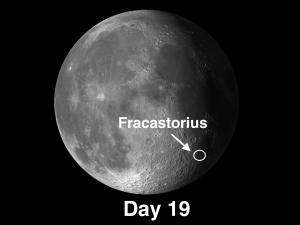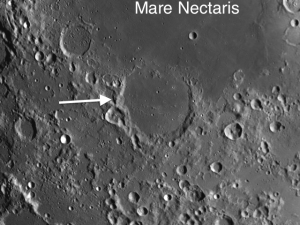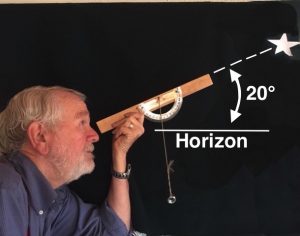The week of February 13-19 takes us from Day 18 to Day 23; these are days following the full moon. This week we will highlight the crater Fracastorius, visible on Tuesday evening after 11:00 PM (the Moon rises around 9:30).
 Fracastorius: [SE/M13] Located on the south shore of Mare Nectaris, this is one of the Moon’s best examples of 1subsidence. The Nectaris lavas were so heavy that the floor of Fracastorius actually cracked as it bent downward and allowed the Nectaris lavas to flow over its northern rim. If you’re lucky and have good optics and good seeing, you might actually glimpse the unnamed rille that crosses the floor from east to west just south of the center. There is a tiny 2.5-mi. crater right in the middle of this rille that may help you spot it. (Daguerre on the north shore [L13] and its adjoining unnamed neighbor have both fallen victim to the same process of subsidence.)
Fracastorius: [SE/M13] Located on the south shore of Mare Nectaris, this is one of the Moon’s best examples of 1subsidence. The Nectaris lavas were so heavy that the floor of Fracastorius actually cracked as it bent downward and allowed the Nectaris lavas to flow over its northern rim. If you’re lucky and have good optics and good seeing, you might actually glimpse the unnamed rille that crosses the floor from east to west just south of the center. There is a tiny 2.5-mi. crater right in the middle of this rille that may help you spot it. (Daguerre on the north shore [L13] and its adjoining unnamed neighbor have both fallen victim to the same process of subsidence.)
 There are some quite small objects on the floor of Fracastorius requiring high quality optics and steady seeing. How many of these can you detect? Make a quick sketch, then come back later to compare.
There are some quite small objects on the floor of Fracastorius requiring high quality optics and steady seeing. How many of these can you detect? Make a quick sketch, then come back later to compare.
OF ADDITIONAL INTEREST ON LUNAR DAYS 18-23: VENUS AT IT PEAK BRIGHTNESS
(repeated from January 2nd blog):
 Throughout February Venus will be at its peak brightness, magnitude -4.8 (in spite of being only 30% illuminated).2 This is bright enough to see in daylight if you know exactly where to look. (And it will dazzle you in a telescope!) Find out the current azimuth and altitude of Venus by using an app like Sky Safari, then to locate Venus use a home-made quadrant (for measuring altitude) and a compass: Attach a protractor to a rectangular stick (like a wooden ruler). Put a screw through the zero point of the protractor, tie a string to the screw and attach a weight to the string. Using your quadrant and a compass, scan the approximate area with your binoculars. With practice you’ll be able to point exactly to the object in question and you’ll have bragging rights to having seen Venus in the daytime! (Take care not to accidentally point your binoculars toward the Sun. Serious eye damage will result!)
Throughout February Venus will be at its peak brightness, magnitude -4.8 (in spite of being only 30% illuminated).2 This is bright enough to see in daylight if you know exactly where to look. (And it will dazzle you in a telescope!) Find out the current azimuth and altitude of Venus by using an app like Sky Safari, then to locate Venus use a home-made quadrant (for measuring altitude) and a compass: Attach a protractor to a rectangular stick (like a wooden ruler). Put a screw through the zero point of the protractor, tie a string to the screw and attach a weight to the string. Using your quadrant and a compass, scan the approximate area with your binoculars. With practice you’ll be able to point exactly to the object in question and you’ll have bragging rights to having seen Venus in the daytime! (Take care not to accidentally point your binoculars toward the Sun. Serious eye damage will result!)
1Subsidence: After the large basins formed, heavy lava rose up through the cracks and fissures that were opened up. The additional weight caused many of the basins to sink toward the center. As a result, shoreline craters would tilt, and sometimes their seaward rims would actually sink below “sea level.” It used to be thought that the inward facing rims of these craters simply melted away because of the intense heat generated by the mare lavas. That explanation has now fallen into disrepute. Charles Wood points out that if that were the case, the rims of these breached craters would not systematically decrease in height toward the basin center, as they do in a large number of instances. Good examples are Daguerre and Fracastorius on the shores of Mare Nectaris, Posidonius in eastern Serenitatis, and Sinus Iridum, the magnificent bay on the northwest shore of Imbrium (Day 10).
2 Paradoxically, Venus is brighter during its crescent phase than when it is at “full moon.” This is because when it is full it is on the far side of the Sun, and during its crescent phases, it is closer to the Earth.
======================
It is highly recommended that you get a copy of Sky and Telescope’s Field Map of the Moon, the very finest Moon map available for use at the telescope. It is available for $10.95 at www.skyandtelescope.com and on Amazon. All features mentioned in this blog will be keyed to the grid on the Field Map and will look like this: Plato: [NW/D9]
Credits:
Courtesy of Gray Photography of Corpus Christi, Texas
Lunar photos: NASA / USGS / BMDO / LROC / ASU / DLR / LOLA / Moon Globe. Used by permission
- Rupes Cauchy: A Best Known Fault on the Moon - July 22, 2024
- Moon Crater Schickard – Crater Floor has Stripes - July 15, 2024
- Moon Craters Langrenus and Vandelinus - July 8, 2024